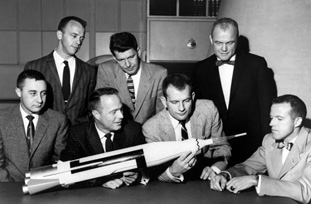Many people gathered to watch Discovery's launch
Click on image for full size
Images courtesy of NASA
STS-95 Launch: "Let the wings of Discovery lift us on to the future."
News story originally written on October 30, 1998
The Space Shuttle Discovery lifted off from Kennedy Space Center on
October 29th at 2:19 p.m. EST. The weather was great as Discovery took 8
1/2 minutes to reach orbit. This was the United States' 123rd
manned space mission.
A huge crowd came to watch
John Glenn
return to space for the second time in 36 years. People who regularly
watch shuttle launches said that the crowd was a lot larger than most
recent launches. In addition to the people watching in person, the
launch was covered live by many major broadcast stations.
Discovery was scheduled to launch at 2 p.m. EST but was delayed for a
total of nineteen minutes: once when a cockpit warning alarm sounded and
once when a private pilot violated the restricted airspace around the
launch site.
There may have been one problem during the launch. NASA officials believe
a panel struck one of the engines. The panel was possibly a door which
covers a parachute which is used to slow the stuttle during landing. They
don't think that this incident will cause any problems with the mission or
the landing.
The crew for the nine-day mission consists of: Curtis L. Brown as
commander; Steven W. Lindsey as pilot; Stephen K. Robinson, Scott E.
Parazynski, and Pedro Duque as mission specialists; and Chiaki Mukai and
Glenn as Payload Specialists.
You might also be interested in:

In 1959, John Glenn was chosen to be a Mercury Astronaut. He became the first American to orbit the Earth. Some things haven't changed - Glenn still has the right stuff!NASA just announced that Glenn,
...more
It was another exciting and frustrating year for the space science program. It seemed that every step forward led to one backwards. Either way, NASA led the way to a great century of discovery. Unfortunately,
...more
The Space Shuttle Discovery lifted off from Kennedy Space Center on October 29th at 2:19 p.m. EST. The weather was great as Discovery took 8 1/2 minutes to reach orbit. This was the United States' 123rd
...more
A moon was discovered orbiting the asteroid, Eugenia. This is only the second time in history that a satellite has been seen circling an asteroid. A special mirror allowed scientists to find the moon
...more
Will Russia ever put the service module for the International Space Station in space? NASA officials want an answer from the Russian government. The necessary service module is currently waiting to be
...more
A coronal mass ejection (CME) happened on the Sun early last month. The material that was thrown out from this explosion passed the ACE spacecraft. The SWICS instrument on ACE has produced a new and very
...more
J.S. Maini of the Canadian Forest Service called forests the "heart and lungs of the world." This is because forests filter air and water pollution, absorb carbon dioxide, release oxygen, and maintain
...more









